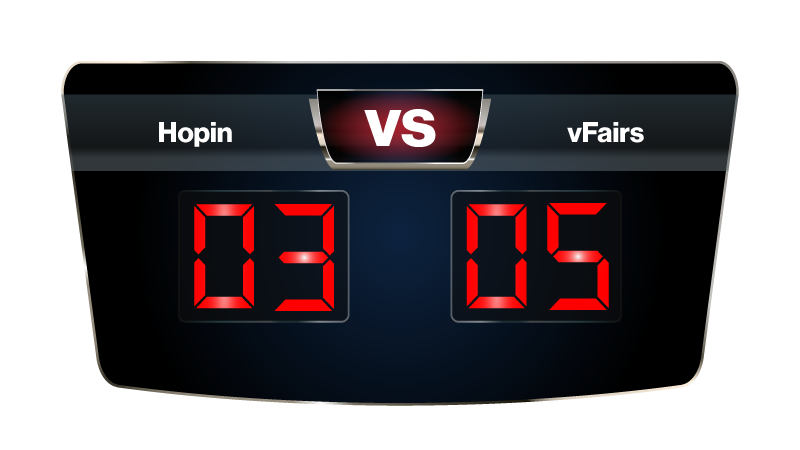Hopin Versus vFairs
Martechvibe pits the two platforms, Hopin and vFairs, against each other on various factors, including user experience, customer support, security, data analytics. The global webinars and virtual events market, which was $1.57 billion in 2020, will reach $4.44 billion in 2025. Despite the post-pandemic return to normalcy, as per research estimates. Moreover, a Grand View […]
Topics

Martechvibe pits the two platforms, Hopin and vFairs, against each other on various factors, including user experience, customer support, security, data analytics.
The global webinars and virtual events market, which was $1.57 billion in 2020, will reach $4.44 billion in 2025. Despite the post-pandemic return to normalcy, as per research estimates.
Moreover, a Grand View Research report states that the virtual exhibitions and tradeshows segment accounted for the largest revenue share of over 30 per cent in 2020, and the numbers are only to increase in the coming years.
It’s the rapidly increasing hybrid work model that has fueled the growth of virtual event platforms. Given the demand, several companies are in the competitive race, focusing on better engagement and experience, most platforms offer similar options but there is always an oompfh factor that makes a platform better.
Consider Hopin and vFairs. Hopin started with a team of eight, and in two years, it became Europe’s popular tech unicorn, with a $5.6 billion valuation. Running virtual, hybrid, in-person, and internal events operations with 800 employees, Hopin has built events for companies like GitLab, Dell, Unilever, Twitch, and Slack.
Competitor vFairs hosts virtual job fairs, career fairs, online trade shows and other business events using 3D virtual environments and embedded webinars. With companies such as Ford, Pearson, Teradata, and Nestle, vFairs hit $30 million in revenue this year.
To deliver better insights, Martechvibe pits the two platforms against each other on various factors, including user experiences, customer support, security, data analytics.
The Showdown
Customer Support: While both offer 24/7 live customer support, Hopin includes a knowledge base that holds answers to every possible question a company might have about hosting on the platform. Including a user manual and a section of FAQs, Hopin’s knowledge base and pop up chatbot on its homepage makes users more receptive.
vFairs has neither a knowledge base nor a home page chatbot, but should the user choose to go through with the onboarding process, customer support gets a lot savvier. From pre-event support for landing pages and 3D lobbies to live event support teams and post-event data reporting support, vFairs intensive customer support makes a knowledge base look insignificant.
Although Hopin also includes live support in the form of a blue chat bubble, the holistic customer support journey offered by vFairs pushes the platform inches ahead.
Winner: vFairs
Security: Virtual events accumulate massive business and customer data, and a rock solid security system is non-negotiable. vFairs’s GDPR compliance statement reveals that it has revised its “data protection policies and procedures to meet the requirements and standards of the GDPR and any relevant data protection laws.”
It also states that the platform’s data subject requests are facilitated through DSAR form, which is all very good. But what tools or security methods does the team use? There are no records. Meanwhile, Hopin’s security team conducts third party penetration tests, vulnerability scanning, and DDoS mitigation. Additionally, it uses infrastructure from Amazon AWS and Google Cloud for data centre hosting.
vFairs tightens its security with two-factor authentication upon virtual event login, but considering Hopin’s environment segregation in application security, training programmes under personal security, and vendor management process under third party security, we acknowledge the clear winner of this round.
Winner: Hopin
Analytics: The analytics page of the Hopin’s event dashboard provides a summary of all the data procured from the event. Initial data of the number of booths created and the number of registrations and ticket sales are also added.
During the event, the turnout, attendee NPS, active attendees, and time spent data among others is developed and presented on the dashboard. Nonetheless, it looks more like a statistics report than data analytics.
vFairs also has a dashboard with event data including registration details, attendee navigation, booths visited, content saved or downloaded, and interactions data. While on first glance, it also looks unimpressive, vFairs does not disappoint.
Apart from a real-time metrics dashboard, the platform allows the brand to track individual user journeys to understand customer behaviour. It offers exhibitor statistics and the personal dashboard is updated in real-time to maximise sponsorship ROI. Additionally, its post-event report allows the brand to filter the data based on the business KPIs.
Although deeper, predictive, and Artificial Intelligence (AI) analytics are not on the table, vFairs fares better than Hopin here.
Winner: vFairs
Customisation and Personalisation: Customisation of Hopin interface — logos, colour combinations, and font selection is available, and it contributes to ease of user access.
Apart from allowing organisers to create personalised demos for attendees before the event, Hopin’s Reception Area, a customisable lobby page, buzzes with possibilities. The window has a custom welcome message box for the organiser, clickable logos, event schedule, unlimited booth options, and a speakers list.
Additionally, every booth has a customisable CTA button for emails when set to “Register Interest” or be a custom text linked to any valid external hyperlink. One can also rename the label of event areas, and add custom registration form fields to derive more information from attendees.
Hopin also allows a customisable livestreaming experience via RTMP. OBS, WireCast, ManyCam, Ecamm, or Switcher Studio can be used to “hybridise” a physical event. Organisers can insert a live video feed from the in-person event onto the Hopin Stage for the virtual attendees.
Meanwhile, vFairs’s booth has a self-select animated avatar feature. For instance, when King Fahd University of Petroleum & Minerals (KFUPM) wanted to source high quality candidates from around the world during their virtual job fair, they used culturally personalised avatars that included a variety of attires and global ethnicities.
With a personalised event agenda, vFairs’s backend system gives you full control of webinar schedules, exhibit booths, user access and more. The platform developed the event builder feature for attendees to be able to browse through sessions and create a personalised view of only the ones they’re interested in. The 3D designs for the virtual environment can be personalised, and the platform also offers immersive rooms and personalised booths. Immersive experiences are a bonus, and vFairs continues to take the lead.
Winner: vFairs
Integration Tools: Hubspot, Salesforce, Kudo, Interprefy, Cvent, Slido, Walls.io, and Marketo are some of the common integration features that both platforms offer. Let’s explore some unique integrations and what it brings to the virtual table.
vFairs has integrated with marketing automation tool Eloqua to let users create new leads from the virtual events. It can also help create event marketing and promotion strategies for the future.
Another vFair integration, KUDO, makes the virtual event more accessible. When event participants speak in regional languages, it provides live translation. Apart from the Zoom integration of fully embedded webinars, vFairs partnered with Restream to allow the event to be live streamed across social media platforms.
While vFairs integrations address a variety of elements for better experience and ease of access, Hopin also has interesting integration features that can attract businesses. For instance, Kahoot, Action Button, Mentimeter, vSpace, and Snapbar, provide various gamification elements for better engagement. This might be a game changer as user experience is always better with interactive elements. But vFairs also has in-built gamification features, including leaderboard, scavenger hunts, polls, and other trivia games.
Interestingly, the Hopin-Miro collaboration allows organisers to add interactive whiteboards; Figma allows the user to present designs and ideas; and the GoFundMe integration adds social impact to the event with a virtual donation for a cause.
Hopin has a range of integrations that covers translation, gamification, CRM, Engagement, Social Media Marketing, Donations, and Captions. Additionally, its acquisition of Streamyard allows organisers to access advanced video production features through the event dashboard. Well, it’s a complete package.
Winner: Hopin
Networking and Chat Options: Networking is a core component of business events, and easy to use chat options are integral to every virtual event. vFair’s chat options holds an embedded live chat as a chat bar that exists till the end of the event. Apart from group and private chats, vFairs also has Breakout Rooms, where events are conducted in smaller groups to increase collaboration and engagement.
Hopin also offers several chat options including Session chat, Booth chat, Meeting chat, Backstage chat, and direct messages. Toggling between many windows seems exhausting on both vFairs and Hopin. Another common feature in both platforms is the capability of two attendees to be randomly paired in a chat room for networking. This chatroulette is an interesting feature that puts both platforms on the same level.
On exploring this matchmaking tool offered by vFairs, we found that the random matching is done with a compatibility test. Only someone with similar interests are paired together to induce meaningful conversations.
Hopin’s random chat option is designed to recreate “coffee-in-the-lobby” conversations. Yes, the networking is random but organisers can create matchmaking groups between the ticketing holders. If the conversation seems worthwhile, the attendees can click on the Connect button to exchange contact information. Both will then be able to view each other’s contact info on the Connections tab of their profile. It’s a pretty cool end to a virtual networking session. Despite the visually jarring chat sessions, point to Hopin?
But wait, vFairs also allows attendees to make notes, add tags, and view profile data while chatting with attendees without leaving the chat window. Chat metrics can be assessed, and the transcripts can be exported. Chat messages can also be published for public viewing, but only after it is vetted by the moderators. Well, these features definitely beat the automatic contact exchange.
Winner: vFairs
Event Marketing: Virtual or in-person, marketing the event is a crucial component that begins with the landing page. With a custom vanity URL, VFairs provides a fully branded landing page that could include promotional videos and speaker bios in multiple languages. Apart from the mobile-friendly page, it allows organisers to create emails with its visual editor and template builder.
Hopin, on the other hand, provides access to the Hopin Canvas, where organisers can design landing pages with modular blocks, use the drag and drop option, and customise with available layouts and themes. What’s interesting is that it enables group purchases at point of check out, and also embedded widgets to enable single ticket purchase.
To help automate campaigns, vFairs offers pre-scheduled group emails, and trigger setups to run those automated email campaigns. The marketing features offered by both platforms are not very impressive and need innovation. However, Hopin creates, tracks, and manages UTM codes directly in the event dashboard for all pre-event marketing campaigns. For this minor feature, point to Hopin.
Winner: Hopin
Navigation: Exploring the virtual event for attendees needs to be seamless and captivating, and the experience largely depends on navigation. Apart from being labelled, vFairs has developed specific navigation menus for every booth, which acts as a guide for attendees. Sometimes custom HTML content is required under the booth tabs for more information about the exhibitors. To address this, vFairs introduced custom tabs in the booth view.
Hopin has no special navigating tools. It has specific areas with specific purposes, including the Reception Area that holds helpful information including instructions, links to sponsors’ websites and the schedule of events. Another window labelled The Stage holds the main event, where all audiences can be viewed in one place.
Due to the jarring user experience of multiple tabs and windows, including the several types of chat options on Hopin, navigation for attendees is easier on vFairs.
Winner: vFairs
And the champion is…
*Drumroll*

It’s been a competitive bout, and due to its enhanced user experience and ease of access, we’ve got to give the edge to vFairs in the eight rounds of the match against Hopin.
Technology has a bigger role to play in virtual event platforms, especially due to the increasing preference of hybrid events across industries worldwide. Both vFairs and Hopin are yet to explore AI, Machine learning, big data, and IoT technologies. With better martech integrations and product developments, the tables might just turn.
If you liked reading this, you might like our other stories
Platform War: TikTok v/s Reels
Taking eCommerce to the Next Level






